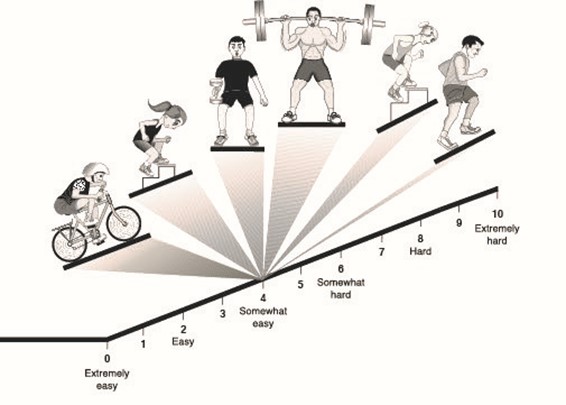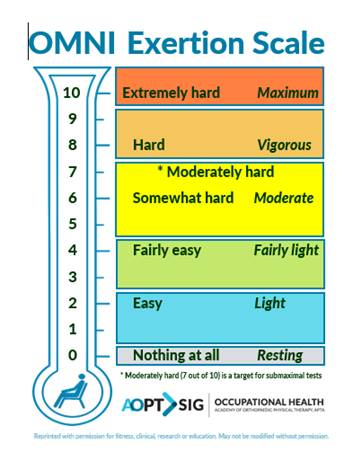By using this site, you are consenting to our use of cookies. To find out more visit our privacy policy.
OMNI Exertion Scale, OMNI Picture System of Perceived Exertion (Adult OMNI Versions)
Summary
What it measures:
The OMNI Picture System is a collection of category scales used for rating of perceived exertion (RPE). Robertson and Noble defined the perception of physical exertion as the subjective intensity of a person’s feelings of effort, strain, discomfort, and/or fatigue when engaged in exercise or other physical activities.1 With OMNI exertion scales, users select a number from 0 to 10 that best corresponds to their perceived intensity of physical exertion.2
This review is focused on variations of the OMNI Picture System of Perceived Exertion that have been studied in adults engaged in aerobic or resistance physical activity. The OMNI scale versions for adults use the keywords, easy and hard, in verbal descriptors that are placed at equal intervals along the 0 to 10 point scale.2 The OMNI Picture System of Perceived Exertion for adults includes scale variations that are primarily distinguished by pictures that depict various types of physical activity such as resistance exercise with barbells,3 treadmill running,4 cycling,5 kayaking,6 elliptical machine,7 elastic resistance exercise bands,8 bench stepping,2,9 and whole-body vibration.10
OMNI scales have been used with populations that include young men, young women, elderly men, elderly women, Italian older males and females, and patients with adductor spasmodic dysphonia. Most of the initial pictorial versions used the descriptor "very low" at the zero-starting point at the bottom of a hill. These descriptors are illustrated in Figure 1 (below), that presents a sampling of representative pictures from OMNI scales for resistance and aerobic activity scales.2

Figure 1. Montage of picture cues for the OMNI. perceived exertion scales.
Reprinted, by permission, from Robertson RJ. Perceived Exertion for Practitioners: Rating Effort With the OMNI Picture System. Champaign, IL: Human Kinetics; 2004.
Mays et al7 were the first to develop and validate a modified adult version of OMNI Ratings of Perceived Exertion Elliptical Ergometer Scale that substituted the descriptor "rest" with a figure of a person standing in place at the zero-starting point. Kraus et al9 developed and validated a modified OMNI rating of perceived exertion scale for use during bench stepping exercise (OMNI-BS) that also substituted the descriptor "rest" with a figure of a person standing in place with one foot on the step at the zero-starting point. Rick Wickstrom developed a color variation of the OMNI Picture System titled, OMNI Exertion Scale, which was introduced by Kotowski et al11 in a platform presentation at the 2022 APTA Combined Sections Meeting (see Fig. 2 below). This modified version was designed for interpreting or prescribing the intensity of workload for a more general range of physical activities for work or other lifestyle activities. This modified OMNI Exertion Scale presents a picture of person sitting at rest and modifies the zero-point descriptor to "nothing at all | resting" at the bottom end of the scale to align with the Heart Rate Reserve method for reporting physical activity intensity. Verbal descriptors and colors were added to further clarify numerical ratings and zones of physical intensity, respectively.

Figure 2. OHSIG-Branded Version OMNI Exertion Scale
The search strategy for this review used the following combinations of key terms for initial identification of reliability and validity articles:
- Reliability articles: "OMNI" AND "exertion" AND "reliability"
- Validity articles: "OMNI" AND "exertion" AND "validity"
Excluded from this review are OMNI scale versions developed for children that use verbal descriptors based upon the keyword "tired."
ICF Domain(s): Activity and participation.
ICF Categories: The OMNI Scale is used to assess perceived physical exertion for a broad range of International Classification of Functioning, Disability and Health (ICF) categories that include:
- Mobility: Walking & Moving Around
- Changing & Maintaining Body Position
- Carrying, Moving, & Handling Objects
- Self-Care
- Other PT/OT Subsequent Limitation
Taskforce Recommendations:
The OHSIG in the Academy of Orthopaedic Physical Therapy has recommended use of perceived exertion scales such as the OMNI 0-10 scale or Borg 6-20 scale when assessing functional capacity or for regulating exercise intensity during work hardening/conditioning programs.
Clinical Insights:
OMNI Exertion Scale has similarities to the 6-20 category scale for rating perceived exertion (RPE) that was developed by Gunnar Borg in the 1960s.28 However, the OMNI metric appears to have a few distinct advantages to other scales, as it is more versatile for applications that include strength and endurance training. Different activities have individual scales that employ unique pictures to depict exertion levels. The color general purpose scale has more applicability to occupational task assessment because it is not limited to specific pictures. The determination of adequate and safe prescriptions for intrasession and intersession training intensity is a challenge for both resistance3,8 and aerobic training.4,5,7
The OMNI Exertion Scale may be used in a similar manner as the Borg 6-20 Scale in graded exercise testing and exercise training applications. When a participant reports an OMNI RPE rating of 7 or moderately hard, this signifies the start of a warning zone for initiation of procedures to safely terminate the test. Multistage protocols for submaximal aerobic step tests typically continue until the client rates the RPE 8 (hard) on the OMNI scale. This level of submaximal intensity is ideal for health club and clinics because it means that the test is low risk and does not require complex monitoring, thus allowing tests to be repeated frequently throughout a conditioning program.
Use of RPE thresholds to guiding test progression or training intensity are particularly helpful when managing patients who are limited by symptoms or taking medications that may alter heart rate.
Both aerobic and resistance training may benefit from using a differential RPE scale. This is one that separates the body into central (heart and lung challenge) and peripheral (legs or arms) areas of fatigue as used in aerobic exercise or into specific muscle groups as used in resistance training. The time-point measurement of RPE across aerobic and resistance training is not the same. In aerobic training the participant should endeavor to maintain the RPE over the duration of the exercise session. Whereas resistance training may seek a peak of RPE as fatigue is accumulated over a set with the endpoint RPE as the goal. In generally healthy individuals, most aerobic training sessions will likely span between 5-7 on the OMNI scale, whereas resistance training may span to higher ranges as is the case with repetition max attempts. The initial RPE point for resistance training varies depending on the goal of the training session. For higher repetition sets, the initial RPE would be closer to 2-4 on the OMNI exertion scale whereas higher intensity sessions with fewer repetitions would begin closer to 6-8 on the working sets.
Determining the range of RPE for aerobic training can be done by examining a graded exercise test or submaximal test and relating the desired work output of the training session to the RPE measured at the corresponding stage of the test. If the RPE begins to drift upward over the course of the training session, more rest may be needed between sets of resistance training, or a break may need to be taken during the aerobic bout. A rise of 2 RPE points between sets is considered a threshold signal for additional rest allowance. As exercise adaptations are realized, individuals should increase volume and intensity to maintain these set ranges. This is crucial to the understanding of all practicing physical therapists when designing exercise routines and testing strength and endurance, especially in an outpatient setting.
For circumstances such as occupational tasks or less healthy populations, some adjustments must be made. Broadly, RPE can be used during workplace tasks to quickly determine the relative intensity workloads for prioritizing workplace interventions. For clinical or older populations RPE target ranges often need to be reduced by 1-3 points when compared with young, healthy individuals. As a rule, intensity levels in most outpatient cardiac rehabilitation or with older adults usually target an intensity level between 4 and 5 on the OMNI scale intensity, which corresponds to about 60% of the heart rate range. It is often beneficial to measure RPE in conjunction with objective measures such as heart rate, blood pressure, or pulse oximetry response to better understand the influence of disease burden, symptoms, or medication.
It is recommended that practitioners prescribe frequency, duration, and intensity ranges that are consistent with guidelines by organizations such as the American College of Sports Medicine when determining initial training loads.29 The OMNI Exertion Scales are vital tools for monitoring the response to work, prescription of therapeutic exercise, and reducing the risk of injury when progressing individuals in their usual work and lifestyle activities.
Members Only Content
Join APTA to get unlimited access to content including evidence-based research, guidance on payment changes, and other resources to help you thrive. Learn more about membership benefits.
Already a member? Log in
Date: May 3, 2022
Contact: practice@apta.org
Content Type: Test & Measure
Rick Wickstrom, PT, DPT, Michael J. Landram, PhD, Joshua Prall, PT, DPT, EdD, MS, Board-Certified Clinical Specialist in Orthopaedic Physical Therapy, and Robert J. Robertson, PhD
Brad Profitt, PT, DPT, DC Ryan McGlawn, PT, DPT
You Might Also Like...
CPG
Advanced Breast Cancer: Diagnosis and Treatment (Updated) [NICE CG81]Feb 19, 2025
This guideline provides recommendations related to the diagnosis and treatment of patients with advanced breast cancer.
CPG
Rotator Cuff Tendinopathy Diagnosis, Non-surgical Medical Care and Rehabilitation: A Clinical Practice GuidelineJan 30, 2025
This guideline, supported by the American Physical Therapy Association, Academy of Orthopaedic Physical Therapy, Quebec Rehabilitation Network, and Quebec
CPG
Overweight and Obesity Management [NICE NG246]Jan 14, 2025
This guideline, from the United Kingdom's National Institute for Health and Care Excellence (NICE), covers the prevention and management of overweight,